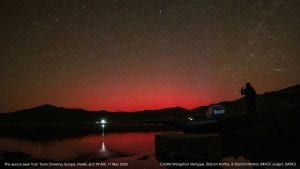The skies over Ladakh lit up in crimson hues on Saturday night as the solar storm brought the famed aurora lights to India.
The solar storm that hit the Earth on the intervening nights of Saturday and Sunday is said to be the strongest in nearly two decades.
Explaining the phenomenon, scientists at the Centre of Excellence in Space Sciences in India (CESSI), Kolkata told PTI that the aurora in Ladakh and elsewhere in the world on Saturday night were the result of solar storms (or coronal mass ejections in scientific language) from the AR13664 region of the Sun that has produced several high energy solar flares, some of which travel to Earth at a speed of 800 km/s.
Besides Ladakh in India, spectacular scenes were also witnessed in Austria, Germany, Slovakia, Switzerland, Denmark and Poland.
In Ladakh, astronomers recorded the scenes from the Tashi Choeling Gompa nunnery inside Hanle Dark Sky Reserve. Stanzin Norla, an engineer at the facility, shared a photo that was also posted on X (formerly Twitter) by the Indian Institute of Astrophysics (IIA).
Stanzin told PTI, “We were fortunate to witness Aurora activities on our all-sky camera during regular telescope observations…It streaked through the sky from about 1 am till 3:30 am.”
Dorje Angchuk, an engineer at the Indian Astronomical Observatory in Hanle, told the agency that the aurora above the Ladakhi skies was a red arc. It was more stable than usual.
“Auroras seen near the north or south poles are dynamic events. They keep changing. But the one witnessed at Ladakh was more stable. It is called the stable auroral red arc. The steady glow remained in the sky for a couple of hours,” said Angchuk.
In a post on Twitter, the IIA also shared a time-lapse video of the scenes in the Ladakhi skies.
Dibyendu Nandi, the head of CESSI at Kolkata, told the agency that severe space weather not seen in at least two decades is being witnessed currently and it is expected to get worse. He added that the scenes in Ladakh’s skies are only visible because of such intense disturbances triggered by solar storms.
Nandi told PTI, “These auroral red arcs are likely caused by heating of the atmosphere by electric currents that are circulating between Earth and outer space. These ring currents get enhanced during geomagnetic disturbances induced by solar storms and thus the likelihood of observing the red auroral arcs is higher at times when we are in the midst of a severe geomagnetic storm…We are witnessing severe Space Weather at levels we have not seen in the last two decades. It might get worse as more solar storms are expected to impact Earth or maybe just more spectacular auroras for all.”
While the crimson hues were most prominent in the lights in Ladakh, blue and purple bands were also seen. The IIA shared the photos.
Link to article –
Watch: Ladakh’s sky lights up with crimson hues amid solar storm
